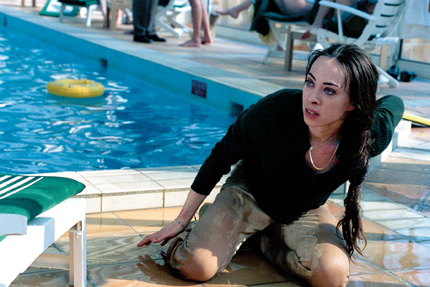
Below is a transcript of the introduction given by Katerina Flint Nicol to The Strange Colour of Your Body’s Tears that kicked off our French Extreme season at the Gulbenkian cinema in Canterbury on 23rd February, 2015.
Good Evening and welcome to the first screening of the Waves of Horror season of French Extreme films. Before I talk about the film we will be watching tonight, The Strange Colour of Your Body’s Tears, I just thought I’d spend some time talking of what is French Extreme Horror. For as we shall see with the other films in the season, that although there is a presumption that the word, Extreme, pertains to gore, blood fest, sex, violence and indeed excessive representations; the word Extreme also refers to the films’ capabilities to push what we consider to be horror to its limits. Our opening film tonight and the film that closes our season, In my Skin, both employ surrealism in aesthetics and narrative in order to subject the audience to the utmost horrifying cinematic experience and to incarcerate the characters in their own nightmares. But all the films that sit under the umbrella of French Extremity, know no limits and adhere to no boundaries and strive to push the frontiers of taste and of what unnerves, scares, repulses, and excites.
So, the term New French Extremity, or New French Extremism, is attributed to the Artforum critic, James Quandt, who coined it in order to band together films that begun to appear at the beginning of the century. Films such as Base-moi (2000), Haute Tension (2003), Frontieres and Inside, as well as growing bodies of work from directors such as Gaspar Noe and Catherine Breillat. Quandt saw in such films similar transgressive and excessive qualities that traverse art-house sensibilities and exploitation cinema alike, while encompassing horror sub-genres such as slashers, home invasion, revenge films and body horror. Centralising the body, particularly that of the female and generally focusing on gender politics, Quandt describes New French Extremism as, ‘determined to break every taboo, to wade in rivers of viscera and spumes of sperm, to fill each frame with flesh, nubile or gnarled, and subject it to all manner of penetration, mutilation and defilement’. Even descriptions have to be extreme and excessive! As the film blogger, Matt Smith writes, the films are a ‘comprehensive snapshot of human anxieties about our bodies, both corporeally and socially’.
Several of the films have generated some controversy in their premieres. Most notably, Gasper Noe’s Irreversible and Pascal Laugier’s Martyrs both premiered at Cannes, where it was reported audiences fainted, vomited, or walked out. I’m not hoping for those responses when Martyrs screens here next month. While some critics have noted the ability of the films for progressive political commentary, portraying contemporary society as isolating, horrific and threatening; others have accused the films of fascism and homophobia.
So, to The Strange Colour of your Body’s Tears. Where to start with such a film? Well, if David Lynch took acid and made a film, this is what it would look like! So, it isn’t surprising that both Bruno Forzani and Helene Cattet have repeatedly stated how their work is influenced by Lynch, having avidly watched Lynch films throughout their teenage years. Indeed, although this is a highly creative and original piece of film making, the film owes much of its aesthetic and cinematic qualities to giallo films, especially Dario Argento’s Deep Red. The title of the film itself references such giallo films as The Strange Vice of Mrs Wardh, What are Those Strange Drops of Blood on Jennifer’s Body and All the Colours of the Dark.
The Strange Colour you Body’s Tears was ten years in the making, a period which saw the husband and wife director team of Bruno Forzani and Helene Cattet, film and release the critically acclaimed, and equally surreal, Amer. Although influenced by giallo cinema, the film is no homage, but rather a re-interpretation, or maybe re-imagining of Giallo language as it pulls upon giallo iconography to tell its story. Certain scenes explicitly reference those from The Strange Vice of Wardh, whilst music extracted from giallo films not only appear, but are an intrinsic part of the construction of the film, appearing in and inspiring original drafts of the script. Indeed, the music functions to provide the feeling of “another time” to the film, as well as directing the pace and rhythm.
The plot is simple, a man searching for his missing wife, very much in the vein of a whodunit or detective story. Much of the narrative occurs in the opening and closing scenes, as the film itself is not concerned with adhering to a rigid or cohesive narrative. Rather, the film concerns itself with pain and pleasure, sex and death to deliver a cinematic experience to the audience, akin to a ‘filmic orgasm’! The story is told through what is experienced through sound and images and hence becomes a sensual and physical experience through which the audience are confronted with their impulses, such as violence and desire. For as Forzani says, ‘a film is not a motorway, it’s about getting a bit lost among primitive things’.







